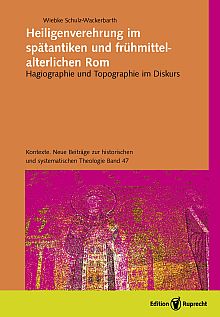Rezension
Bryn Mawr Classical Review vom 24.07.2020
The present book is the revised version of a dissertation submitted to the Faculty of Theology in Göttingen in 2014. »This book examines the discourse on archaeological legacies and hagiographic sources using the example of selected saints in Rome« (page 9). The focus is on how the faithful perceived and venerated these saints and how their contemporary interpretation affected the formation of legends, the cityscape, and the development of the veneration of individual martyrs. The book is divided into six major sections. The first two sections analyse the discourse of hagiography and topography in general and the veneration of saints in late antiquity in particular. They are intended as an introduction to the subject and are followed by the section »Saints in Rome,« which deals specifically with Peter and Paul, Laurence, Agnes, and Mary. In the chapters on Laurence and Agnes, various other saints are included whose veneration is connected with these two.
Schulz-Wackerbarth begins by defining hagiography, which she understands as all texts dedicated to the memory of saints. She then presents an overview of the sources and their individual features. The aim is to clarify the interconnectedness of texts, buildings, and images. Schulz-Wackerbarth argues that the legends around the saints arose from the interconnectedness of these three elements. The section »Hagiography and Topography in Discourse« is essentially a research report and is quite informative. However, many parts of the analytical section of the book are also written like a research report, such as »Legend and Topography.« There is no intensive examination of the sources. I would like to illustrate this with an inscription that she quotes. It is a poem by Damasus for the apostles Peter and Paul in the basilica on the Via Appia, and it reads:
»You who ask for the names of Peter and Paul should realize that the saints once lived here. The East sent the disciples, which we gladly confess. Because of the merit of their blood, they followed Christ through the stars and entered the heavenly womb and the kingdom of the pious; and it came to Rome to claim them as its citizens. This, you new stars, is what Damasus wants to proclaim in your praise.«[1]
Schulz-Wackerbarth deduces from Damasus’ poem that the place of worship on the Via Appia was created on the assumption that the apostles lived there. It is questionable, however, whether hic habitasse prius sanctos in the poem refers to a place of residence of Peter and Paul rather than to Rome, since it later says, in reference to Peter and Paul. Roma suos potius meruit defendere cives. The poem and its intention is not positioned within the complete works of Damasus, as is later the case also with the Liber pontificalis. The fact that the donation and building lists of the Liber pontificalis are difficult to interpret, since they represent only a part of the papal activity, is not mentioned at all. There is no in-depth examination of the respective texts.
It is also inexplicable to me why, when discussing the apse mosaic of San Lorenzo fuori le mura, no mention is made of the large inscription that belongs to the mosaic. Nor does the author mention Pelagius II and his motives for having the inscription made. This unreflective approach to the sources runs through the whole book. To talk about the discourse of sources afterwards seems, given these omissions, to be problematic. In the treatment of Saint Agnes, the inscription in the church San Agnese, built under Pope Honorius I, is not mentioned either. In any case, the inscription should have been used for a more intensive localization of the cult of saints. The significance of the inscriptions, which were visible to the entire congregation, for the tradition of the cult on the one hand and for the self-representation of the popes on the other hand, is not discussed at all. On the whole, theses original to the author, such as that on page 117 ff. regarding the burial place of Hippolytus, remain the exception.
The book thus provides a good overview of the state of research, but offers hardly any new insights.
Sebastian Scholz
Notes
[1] Antonio Ferrua, Epigrammata Damasiana, Città del Vaticano 1942, No. 20: Hic habitasse prius sanctos cognoscere debes | Nomina quisque Petri pariter Paulique requiris. | Discipulos Oriens misit quod sponte fatemur | Sanguinis ob meritum Christum per astra secuti | Aetherios petiere sinus regnaque piorum: | Roma suos potius meruit defendere cives. | Haec Damasus vestras referat nova sidera laudes.








